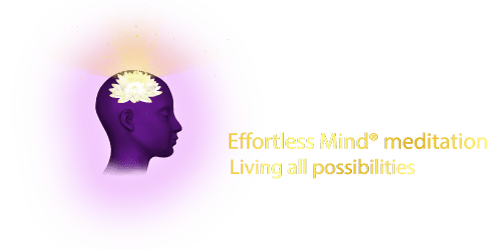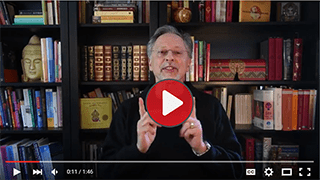The Secret of Controlling the Unruly Mind
Home » The Secret of Controlling the Unruly Mind
(Adapted from the book, Effortless Mind: Meditate with Ease by Ajayan Borys)
“My mind is just too unruly. I have too many thoughts and can’t meditate.”
Nearly everyone who’s ever sat to meditate, at one time or another, has felt this. You sit hoping to feel your mind settle into quiet, if not bliss, and all you get are thoughts. What could be more frustrating!
 Well, in this article, I’m going to give you the secret of “controlling” the unruly mind. In fact, I’ll give you the first part of that secret in 5 words: You can’t control your mind.
Well, in this article, I’m going to give you the secret of “controlling” the unruly mind. In fact, I’ll give you the first part of that secret in 5 words: You can’t control your mind.
Wait! Before you click away, there’s more. There is a secret here that will transform your meditation, so read on…
The Tao of Meditation
If you’ve ever tried to meditate (note the word, “tried”) the moment you attempt to focus, other thoughts crowd in. It’s almost like magic. The mind’s very nature is opposed to control; just like you, your mind wants to be free. So let it. Don’t oppose you mind, work with it. That’s the Tao of meditation. We don’t control the mind, and yet the mind does quiet down. The mind becomes controlled, but not by you or me; rather — and this is a great secret of meditation — the mind can be effortlessly controlled by its own nature.
How can the unruly mind control itself? Well, actually the mind is not so unruly. There is a method to its madness, and that method is this: the mind is spontaneously drawn to greater pleasure, greater happiness. The freedom your mind wants is precisely the freedom you want: to seek your own happiness.
Aren’t we all naturally drawn to what we feel will make us happy? This is true whether we seek a satisfying career, a wonderful soul mate, a beautiful home, car, boat, the latest smartphone, our favorite dessert, sex, fame, wealth — whatever we feel might bring us happiness. The mind automatically feels attracted to it. We can’t help it.
This draw toward greater happiness permeates the mind. In the words of Johann Wolfgang von Goethe, “Happiness is a ball after which we run wherever it rolls, and we push it with our feet when it stops.” I would go so far as to say that this pull toward perceived happiness is to the mind what the law of gravity is to physical objects — it is that powerful a force within us, invisibly driving humanity in all its endeavors.
The good news is that when it comes to meditation, this powerful force is not an obstacle. Yes, those who try to control the mind will find its restless search for happiness to be an obstacle. For them the mind will be like a monkey jumping wildly from limb to limb. Yet as my first teacher, Maharishi Mahesh Yogi, used to say, the mind is not a wild monkey at all, but a bumblebee going from flower to flower in search of nectar. Once we understand this, we can simply point the mind in the direction of that nectar of greater happiness instead of trying to forcibly control it. The mind’s own nature will begin to work for us instead of against us. This is the great secret of effortless meditation.
So, where is greater happiness for the mind? Simply put, it is in transcending to subtler levels of the mind, which is what meditation is all about. Once you approach meditation with ease, you will discover the great charm that lies within, in the inner peace, stillness, expansiveness, intelligence, and creativity at the quieter levels of awareness. Once you stop trying to control it, your mind will discover that the experience of its own depths is true nectar.
Meditation is said to bring you to what in Sanskrit is called ananda, a state of bliss. You don’t need to force your mind to go to bliss; you need only point your mind in the right direction and let go, and the law of gravity of the mind — the draw toward greater happiness — will do the rest. This is why the Tao of meditation works best. This is the practical way to control the mind, not by any exertion. Every technique of meditation that I teach is based on this principle, which makes meditation efficient and effortless. That’s why I call it Effortless Mind® meditation.
Does this mean you won’t have thoughts while meditating? Not at all. As long as you have a mind, you will have thoughts. But once you allow your mind to transcend toward the charm that lies within, the thoughts become less and less significant. Let them come and go; they are not your concern. In this way, you become released from the grip of thoughts; your mind is freed to follow its natural attraction to peace, stillness, expansion, and inner delight. And at times the thoughts will cease, and at that point you will be in the state of “no mind.” (More on this in a later blog.)
To better understand how thoughts can coincide with deep meditation, allow me to offer a final metaphor. Think of your mind as an ocean. Until now you’ve been hanging out on the surface of that ocean — the conscious thinking level of the mind — bouncing from one thought wave to the next, buffeted by desires, musings, worries, irritations, ambitions, insights, and so on. Once you start to meditate, you slip beneath the surface and begin to descend into the depths of your mind. As soon as you slip beneath the surface, you experience inner silence; and as you descend, the silence becomes deeper, richer, and filled with the light of being. Yet the waves on the surface will likely continue. The whole ocean does not have to become perfectly still for you to experience the inner silence of meditation. You can abide deep within, drawn by that increasing peace and well-being, while thoughts go by on the surface of your mind. And now and then you will rest on the ocean’s floor, where all is still . . .
So the bottom line: Thoughts do not pose an obstacle to meditation, but the idea that you shouldn’t have thoughts does. If you pit yourself against the nature of your mind to think, there will be a loser, and it will be you!
To experience the depths of Effortless Mind meditation for yourself, check out my meditation membership site, which provides detailed video instruction and follow-up, as well as advanced instruction. You’ll be enjoying the many benefits of meditation in no time. Or, get a taste by clicking the link to the free guided 10-minute meditation to the right of this article.
Enjoy!
Ajayan Borys





